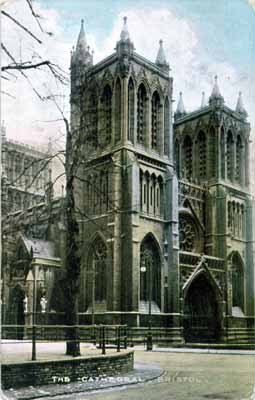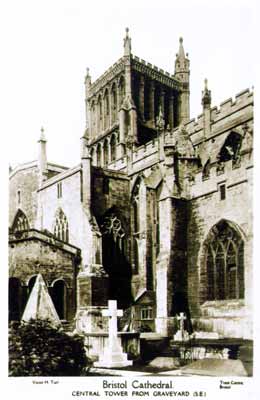
Bristol UK Postcards - The Cathedral (3)

Bristol Cathedral
This postcard, posted in Clifton on September 30th, 1906, has the printed text...
The London Stereoscopic Company Series

Bristol Cathedral
This unused postcard has the printed text...
The "National" Series
Printed in Britain

Bristol Cathedral - Central Tower from Graveyard
This unused postcard has the printed text...
Victor H. Turl
Tram Centre, Bristol

Bristol Cathedral - Chapter House
This unused postcard has the printed text...
Victor H. Turl
Tram Centre, Bristol
Robert FitzHardinge founded the Abbey of the Black Canons of St. Augustine in 1140 in the fields to the west of the town, and it was ready for its dedication in 1146. The abbey was well endowed from its foundation and held benefices in Ireland and South Wales, despite this the abbey was frequently in debt. Abbot Richard was the first abbot and was here for 38 years, the 5th was Abbot David (1216 - 34) who built the Elder Lady Chapel. The running of the abbey was always disorderly, the bishops of Worcester constantly complaining to the abbot. In 1278 Bishop Giffard said of the abbey "damnabilitier prolapsum", which can be translated as being in a state of criminal backsliding.
Between 1306 and 1132 the abbot was Abbot Edmund Knowle who started an extensive rebuilding of the Abbey for it was was falling into disrepair. He rebuilt the choir, aisles, Lady Chapel, Berkeley Chapel and the Sacristy. The Abbey was rebuilt wider than before and with windows that stretched to the roof. This design meant he couldn't use flying buttresses to support the roof , so instead built stone beams inside of it. The design of this makes Bristol Cathedral unique in that it has three aisles all of equal height. But Bishop Cobham in 1320 still had cause to criticise the running of the abbey. Abbot John Snow (1332 - 41) continued the rebuilding. When Bishop de Bransford visited the abbey in 1339 he was pleased to find the building in far better repair than it had been for a long time. He was most definitely not pleased to find that the most part of it was still roofless. Abbot Snow and his successor, Ralph Aske, carried on the rebuilding and it was completed around 1350.
Later Abbots left their mark on the building too. Abbot Newbury (1428 - 1473) built the central tower and transepts. Abbot William Hunt (1473 - 1481), using a great deal of his own money, carried on the work of the transepts and cloisters. Abbot John de Newland (Nailheart) (1481 - 1515) carried out extensive work and his mark or 'rebus', a heart pierced with three nails, can be seen in various places around the Cathedral. Nailheart was one of the best abbots the abbey had till then and he was also known as "The Good Abbot". Abbot Robert Elliot (1515 - 1526) built the upper portion of the gatehouse.
Although not the grandest Cathedral in the country it is well worth visiting. The choir seats (Misericords) have excellant carvings on them, showing the story of Reynard the Fox, his adventures and eventual hanging. Others show more homely scenes.
After Abbot Elliot, Abbot John Somerset (1526 - 33) did make some alterations but the buildings fell into decay again and in 1533 Archbishop Cranmer stayed there for 19 days, putting right many things that were amiss. The Abbey had fallen to such a state that the Canon's had to send in the town for their meals which were given as loans or gifts. Abbot William Burton (1533 - 7) also made some slight alterations.
At the Dissolution of the Monasteries in the reign of Henry VIII it was surrendered to the Crown on 9th December 1539 by Abbot William Morgan. Henry VIII had promised that new dioceses would be founded to make up for the loss of the monasteries, but in the end only six were formed, Bristol being one of them. So, in 1542 the Monastery Church of St. Augustine's Abbey became Bristol Cathedral with Paul Bush (1542 - 54) the first Bishop.
By then the Norman nave was so decayed that it was walled off by Paul Bush, who was the first Bishop. He lies buried within it's walls. The rot didn't stop there and in the reign of Elizabeth I (1558 - 1603) the nave was let out for private dwellings and houses were built around what was left of the Abbey buildings.
The Cathedral suffered relatively lightly during the Civil War (1642 - 1651), with just the lead being stripped off the roof. The people of Bristol did far worse damage during the riots of 1831. The Bishops' Palace was destroyed and the Chapter house which contained many priceless documents was broken into. The documents were thrown to the floor and burnt. The main Cathedral building was also broken into but the Sub Sacrist or verger, a brave man named William Phillips, with an iron bar in his hands persuaded the mob to desist in the destruction of their heritage.
A great deal of restoration work was carried out between 1660 and 1685, Edward Colston (1636 - 1721) paying for a large part of it. In 1720 it was said to be in excellent condition, but it wasn't until 1835 that the houses built on the site were demolished.
In 1836 it was decided to merge Bristol with the Gloucester diocese and for 61 years Bristol was without a Bishop. To the hurt of many Bristolians the city was known as a place with 'Half a church, half a Bishop'. They could hardly answer back as the nave was now wrecked and the place was unfit to be called a Cathedral.
Major restoration was undertaken between 1852 and 1860 and in 1868 a fund was opened to rebuild the nave. This was dedicated in 1877 and two new towers built by 1888. The architect was G. E. Street who supervised the work until his death in 1881, the work then being handed to John Loughborough Pearson. In 1897 Bristol once again became a Cathedral city.
Many eminent people are remembered in the building, the Elizabethan writer, Hakluyt (1553 - 1616), William Wycestre (15th Century writer), Edward Colston (philanthropist), Samuel Wesley (son of Charles Wesley, the hymn writer), Southey (poet), Muller (artist) and Mary Carpenter known for her philanthropic work amongst young girls.
Bristol Postcards: First Prev. 1 2 3 4 5 6 7 8 9 10 11 12 13 14 15 16 17 18 19 20 21 22 23 24 25 26 27 28 29 30 31 32 33 34 35 36 37 38 39 40 41 42 43 44 45 46 47 48 49 50 Next Last
This page created 26th March 2010, last modified 31st March 2010